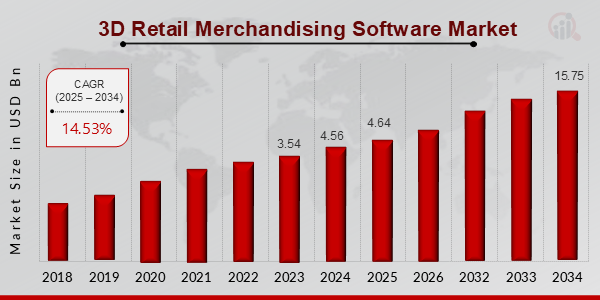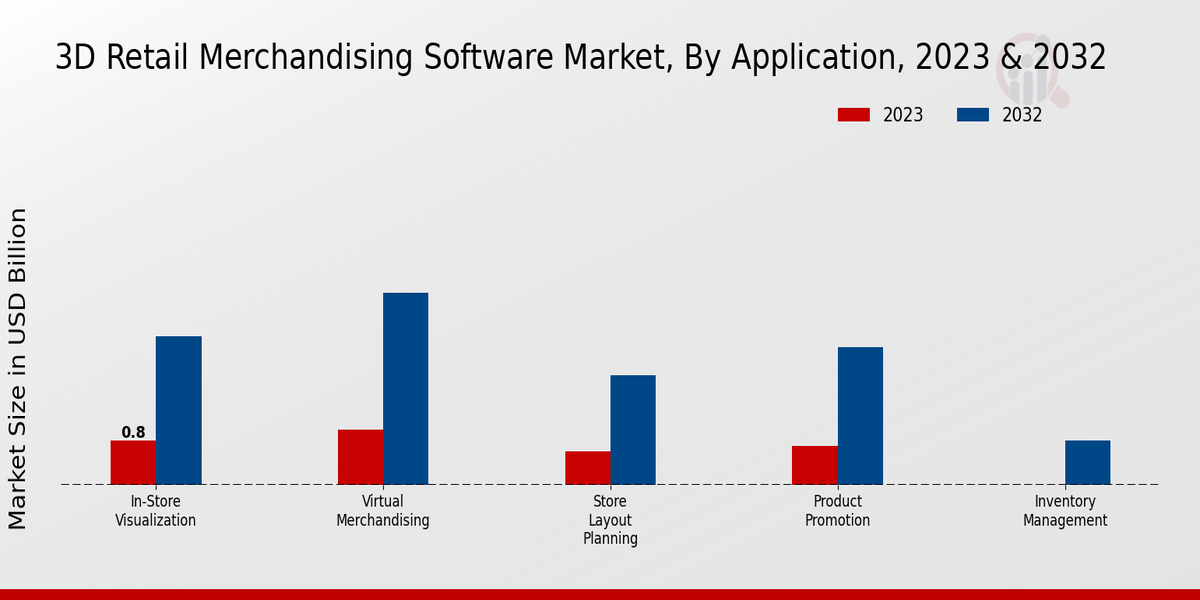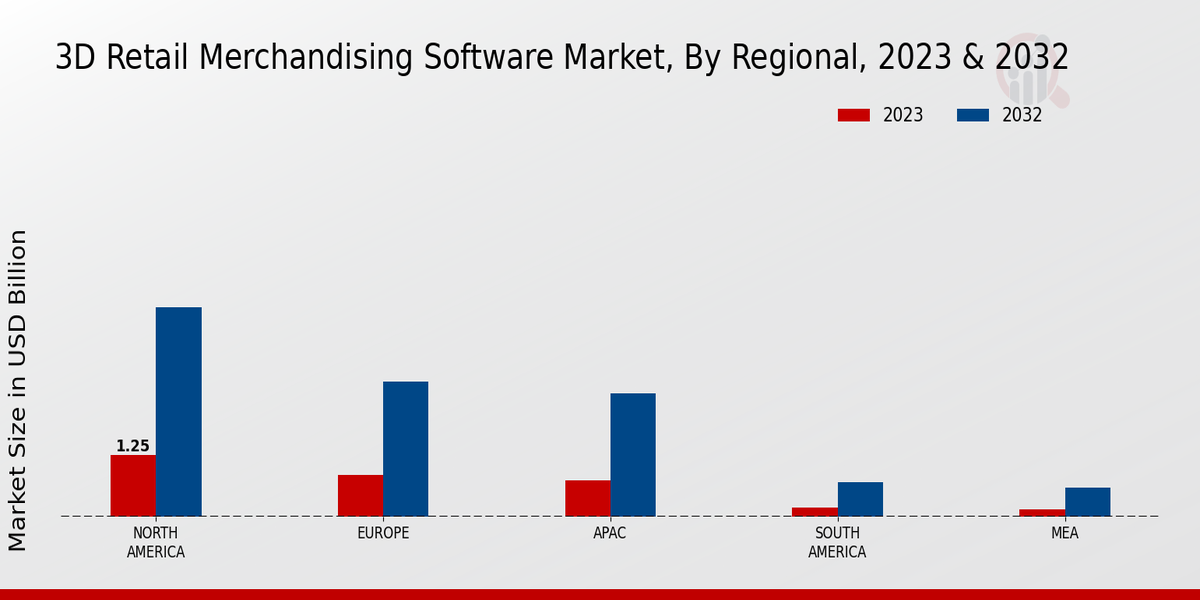3D Retail Merchandising Software Market Overview
3D Retail Merchandising Software Market is projected to grow from USD 4.64 Billion in 2025 to USD 15.75 Billion by 2034, exhibiting a compound annual growth rate (CAGR) of 14.53% during the forecast period (2025 - 2034). Additionally, the market size for 3D Retail Merchandising Software Market was valued at USD 4.56 billion in 2024.
Key 3D Retail Merchandising Software Market Trends Highlighted
The 3D Retail Merchandising Software Market is significantly driven by the growing need for enhanced customer experiences in the retail environment. Retailers are increasingly focusing on creating immersive shopping experiences that incorporate 3D visualizations. This technology allows businesses to present their products in a more engaging way, which can lead to improved customer interaction and satisfaction. Additionally, the expansion of e-commerce and digital platforms is encouraging retailers to adopt 3D merchandising as a way to stand out in a competitive market. The ability of 3D software to streamline inventory management and optimize store layouts further supports its adoption.
Opportunities to explore the realm of 3D retail merchandising software include the integration of augmented reality (AR) and virtual reality (VR) technologies. These advancements can elevate the shopping experience by allowing customers to visualize how products will fit into their lives before making a purchase. Furthermore, smaller retailers can leverage these tools to compete with larger brands, democratizing access to display technologies that were once reserved for bigger players. Customized and personalized shopping experiences are gaining traction, providing new avenues for software development focused on user-centric solutions.
Recent trends indicate a shift towards cloud-based 3D merchandising solutions, which offer greater flexibility and scalability for retailers.
This transition is making it easier for businesses to access innovative tools without the need for extensive in-house IT resources. As retailers recognize the importance of data analytics, integrating 3D merchandising with data-driven insights is becoming more prevalent. Ultimately, the synergy between technology, customer engagement, and data utilization is shaping the future of retail merchandising, encouraging ongoing investment in 3D solutions.
Figure1: 3D Retail Merchandising Software Market, 2025 - 2034

Source: Primary Research, Secondary Research, Market Research Future Database and Analyst Review
3D Retail Merchandising Software Market Drivers
Increasing Demand for Enhanced Customer Experience
The 3D Retail Merchandising Software Market Industry is experiencing a significant shift towards enhancing customer experience in retail environments. As consumers continuously seek more engaging and immersive shopping experiences, retailers are adopting advanced technology solutions to meet these demands. 3D retail merchandising software allows businesses to create lifelike displays and virtual stores, which can significantly enhance the overall shopping experience. Such software empowers retailers to visualize their products in realistic settings, thereby enabling better merchandising strategies and layout designs. The operational efficiency gained through these technologies also caters to evolving consumer preferences for convenience and personalization.
Enhanced customer engagement leads to higher conversion rates as shoppers are more likely to purchase when they can interact with products in more intuitive ways. Moreover, this adoption of technology aligns with the rising trend of omnichannel retailing, where seamless integration of digital and physical shopping experiences is paramount. As the demand for elevated in-store experiences escalates, the 3D Retail Merchandising Software Market grows concurrently, profoundly impacting its trajectory and facilitating innovative solutions in retail.
Technological Advancements in Retail Software Solutions
Technological advancements play a vital role in propelling the 3D Retail Merchandising Software Market Industry forward. The integration of cutting-edge technologies such as augmented reality (AR) and virtual reality (VR) enhances the capabilities of merchandising software, allowing retailers to visualize product placements and store layouts with unprecedented accuracy. These innovations not only improve efficiency in product management but also facilitate more effective marketing strategies. As technology continues to evolve, retailers are compelled to adopt these advanced tools to stay competitive and meet customer expectations.
Growth of E-commerce and Online Retailing
The rapid growth of e-commerce has significantly influenced the 3D Retail Merchandising Software Market Industry. With an increasing number of consumers preferring online shopping, retailers are investing in 3D software solutions to create online environments that replicate the physical shopping experience. These technologies help portray products in a more appealing manner, increasing consumer engagement and retention in the ever-expanding e-commerce landscape.
3D Retail Merchandising Software Market Segment Insights
3D Retail Merchandising Software Market Application Insights
The 3D Retail Merchandising Software Market within the Application segment showcases significant potential, with an overall market valuation of 3.1 USD Billion in 2023 and an anticipated growth trajectory leading to 10.5 USD Billion by 2032. In this segment, In-Store Visualization emerges as a critical application, boasting a valuation of 0.8 USD Billion in 2023 and expected to reach 2.7 USD Billion in 2032. This application significantly enhances the shopping experience by allowing retailers to create realistic visual representations of stores, thereby improving customer engagement and decision-making.
Virtual Merchandising also plays a vital role in this market, starting at a valuation of 1.0 USD Billion in 2023 and projected to grow to 3.5 USD Billion in 2032. By integrating advanced technology and immersive designs, Virtual Merchandising aids retailers in showcasing products creatively and effectively, fostering brand loyalty and higher sales. Store Layout Planning is valued at 0.6 USD Billion in 2023, with a projected increase to 2.0 USD Billion by 2032. This application is essential for optimizing store layouts, which can directly enhance customer flow and maximize product visibility, underpinning operational efficiency.
Product Promotion holds a valuation of 0.7 USD Billion in 2023 and is expected to grow to 2.5 USD Billion in 2032. This emphasizes the application’s importance in strategizing marketing efforts, using 3D tools to enhance promotional campaigns that attract consumer attention. Lastly, while Inventory Management is less dominant, valued at 0.0 USD Billion in 2023 with projections of 0.8 USD Billion by 2032, it represents a growing area for retailers looking to leverage 3D technologies for better stock visualization and management.
Each of these applications reflects the broader trends in the 3D Retail Merchandising Software Market, highlighting an industry increasingly focused on technology to improve customer experiences, streamline operations, and enhance marketing strategies.The growing adoption of these technologies demonstrates significant opportunities for retailers as they adapt to evolving consumer expectations and market dynamics.
Figure2: 3D Retail Merchandising Software Market, By Application, 2023 & 2032

Source: Primary Research, Secondary Research, Market Research Future Database and Analyst Review
3D Retail Merchandising Software Market Deployment Type Insights
The Deployment Type segment, encompassing On-Premise and Cloud-Based solutions, plays a crucial role in this market's dynamics. The flexibility and scalability offered by cloud-based systems make them particularly appealing to retailers looking to adapt swiftly to changing market conditions, thereby driving their adoption and fostering competitive advantage. Conversely, On-Premise solutions, while often requiring more upfront investment, provide clients with greater control over their data and processes, appealing to organizations with stringent data security requirements.
The revenue generated from these deployment types reflects the evolving preferences of retailers as they strive to utilize advanced technologies in order to enhance customer engagement. This segment is critical for understanding global market statistics, as it highlights the various approaches retailers are taking toward integrating 3D merchandising solutions. As the industry continues to evolve, insights into the Deployment Type segment will remain vital, presenting both opportunities for growth and challenges related to technological integration and user adaptation.
3D Retail Merchandising Software Market End Use Insights
The 3D Retail Merchandising Software Market has positioned itself as a significant asset across diverse end-use applications. Retail stores are increasingly investing in 3D merchandising solutions to enhance in-store experiences and better showcase products. E-commerce platforms have become a prominent space for 3D visuals, allowing customers to interactively view products, thereby driving conversion rates. Wholesale distribution also benefits from these software solutions as they streamline product presentations, aiding in better decision-making. Meanwhile, shopping malls have found value in using 3D software for immersive layouts that enhance visitor engagement and foot traffic.
Each segment plays a vital role in reinforcing the adoption of advanced 3D technology, significantly contributing to the overall 3D Retail Merchandising Software Market revenue and setting a course for sustained market growth in the years leading to 2032.
3D Retail Merchandising Software Market Features Insights
The segment focused on 3D Visualization plays a crucial role as it enhances the customer experience by providing immersive product displays. Additionally, Analytics and Reporting features are significant, empowering businesses with data-driven insights to optimize merchandising strategies and drive sales. Collaboration Tools are becoming essential for teams working remotely, facilitating better communication and project management. Moreover, Integration with Existing Systems is vital, as it enables companies to streamline processes and improve efficiency by seamlessly connecting with their current infrastructure.
Overall, these features not only cater to the evolving needs of retailers but also align with trends towards digital transformation, significantly contributing to the 3D Retail Merchandising Software Market revenue growth. With a projected expansion reaching 10.5 USD Billion by 2032, the market is set for notable advancements, backed by the rise in technology adoption and innovation within the industry.
3D Retail Merchandising Software Market Regional Insights
The 3D Retail Merchandising Software Market is expected to experience significant growth across various regions, with North America holding the majority share, valued at 1.25 USD Billion in 2023 and projected to reach 4.25 USD Billion by 2032. This dominance is attributed to advanced technology adoption and a strong retail presence. Europe follows with a valuation of 0.85 USD Billion in 2023, increasing to 2.75 USD Billion in 2032, driven by the region's focus on enhancing merchandising strategies through 3D software.
The Asia-Pacific (APAC) region showcases a growing opportunity, starting at 0.75 USD Billion in 2023 and expected to reach 2.5 USD Billion by 2032, influenced by increasing retail activities and consumer engagement. South America and the Middle East and Africa (MEA) regions are emerging markets, with valuations of 0.2 USD Billion and 0.15 USD Billion in 2023, anticipated to reach 0.7 USD Billion and 0.6 USD Billion, respectively by 2032. The overall market growth is fueled by the demand for enhanced customer experiences and the ability to visualize products in a realistic manner, highlighting significant opportunities for industry players.
Figure3: 3D Retail Merchandising Software Market, By Regional, 2023 & 2032

Source: Primary Research, Secondary Research, Market Research Future Database and Analyst Review
3D Retail Merchandising Software Market Key Players and Competitive Insights
The 3D Retail Merchandising Software Market has been experiencing significant growth due to the increasing demand for innovative technologies that enhance customer engagement and optimize retail operations. As retailers strive to create immersive shopping experiences, the incorporation of 3D merchandising solutions into their strategies has become vital. This market is highly competitive, with various companies offering advanced software solutions that enable retailers to visualize their products in three dimensions. The landscape is characterized by rapid technological advancements, the need for personalized shopping experiences, and an emphasis on data analytics, all of which contribute to the competitive dynamics among market players.
Companies are investing significantly in research and development to ensure that they can meet the diverse needs of retailers and stay ahead in this evolving market.
Oracle has made a substantial mark in the 3D Retail Merchandising Software Market, leveraging its extensive experience in enterprise solutions to deliver comprehensive and innovative offerings. The company’s strengths lie in its robust technology framework, which integrates seamlessly with existing retail systems, thereby ensuring a smooth user experience. Oracle's advanced analytics capabilities give retailers deep insights into customer preferences and inventory management, helping them make data-driven decisions. The company's scalable solutions cater to diverse retail sectors, allowing businesses to tailor their merchandising strategies efficiently.
Furthermore, Oracle’s strong brand reputation and extensive customer support infrastructure enhance its market presence, positioning it as a trusted partner for organizations looking to implement 3D merchandising solutions.
3D Inventory is another key player in the 3D Retail Merchandising Software Market, offering specialized tools that provide retailers with detailed visualization and inventory management capabilities. The unique features of 3D Inventory’s software solution focus on simplifying the visual merchandising process by enabling users to create accurate and realistic representations of their products in a 3D format. This not only enhances the merchandising impact but also assists retailers in optimizing their layouts for better customer flow and engagement.
The company emphasizes user-friendly interfaces and customizability, which allow clients to align the software with their specific branding strategies. 3D Inventory's commitment to innovation and adaptability in a rapidly changing marketplace strengthens its position, making it a valuable contender for retailers aiming to enhance their merchandising efficiency through advanced technologies.
Key Companies in the 3D Retail Merchandising Software Market Include
3D Retail Merchandising Software Market Industry Developments
The 3D Retail Merchandising Software Market has witnessed significant recent developments, with companies like Oracle, SAP, and Autodesk focusing on enhancing their offerings through innovative technologies. Unity Technologies is gaining traction in the market with its advanced visualization tools, while NVIDIA and Epic Games are making strides in 3D rendering capabilities that are crucial for retail applications.
Additionally, 3D Inventory and Cin7 are expanding their service ranges to cater to the evolving needs of retailers seeking more effective merchandising solutions. The market is also seeing a trend in merger and acquisition activities, including strategic collaborations between smart retailers and renowned software providers like PTC and TIBCO Software, which aim to integrate advanced technologies into retail environments. These moves not only enhance market competitiveness but also pave the way for accelerated growth in market valuation.
The influx of investment into technology and innovative solutions is expected to elevate the overall standards of retail merchandising, allowing for more interactive and customer-centric shopping experiences. As a result, these developments are shaping the future landscape of the 3D Retail Merchandising Software Market, indicating robust growth potential moving forward.
3D Retail Merchandising Software Market Segmentation Insights
|
Report Attribute/Metric
|
Details
|
|
Market Size 2024
|
4.56 (USD Billion)
|
|
Market Size 2025
|
4.64 (USD Billion)
|
|
Market Size 2034
|
15.75 (USD Billion)
|
|
Compound Annual Growth Rate (CAGR)
|
14.53% (2025 - 2034)
|
|
Report Coverage
|
Revenue Forecast, Competitive Landscape, Growth Factors, and Trends
|
|
Base Year
|
2024
|
|
Market Forecast Period
|
2025 - 2034
|
|
Historical Data
|
2019 - 2023
|
|
Market Forecast Units
|
USD Billion
|
| Key Companies Profiled |
Oracle, 3D Inventory, Unity Technologies, SAP, Smart and Final, INFOR, Cin7, Epic Games, PTC, Autodesk, NVIDIA, Adobe, Siemens, TIBCO Software |
| Segments Covered |
Application, Deployment Type, End Use, Features, Regional |
| Key Market Opportunities |
Increased demand for immersive experiences, Integration with AR and VR technologies, Expansion into e-commerce platforms, Enhanced analytics for consumer behavior, Rising adoption among small retailers |
| Key Market Dynamics |
Increased demand for virtual experiences, Growing importance of visual merchandising, Rising adoption of AR/VR technologies, Enhanced personalization in retail, Cost-effective inventory management solutions |
| Countries Covered |
North America, Europe, APAC, South America, MEA |
Frequently Asked Questions (FAQ):
The market was expected to be valued at 15.75 USD Billion in 2034.
The expected CAGR for the market is 14.53% from 2025 to 2034.
North America is projected to hold the largest market share, valued at 4.25 USD Billion in 2032.
In-Store Visualization is expected to reach a market value of 2.7 USD Billion in 2032.
Major players include Oracle, Unity Technologies, SAP, Epic Games, and Autodesk.
Virtual Merchandising is anticipated to be valued at 3.5 USD Billion in 2032.
The market for Store Layout Planning is expected to grow to 2.0 USD Billion by 2032.
Inventory Management is predicted to reach a value of 0.8 USD Billion by 2032.
The APAC region is projected to have a market value of 2.5 USD Billion in 2032.
Product Promotion is expected to reach 2.5 USD Billion in market value by 2032.

















